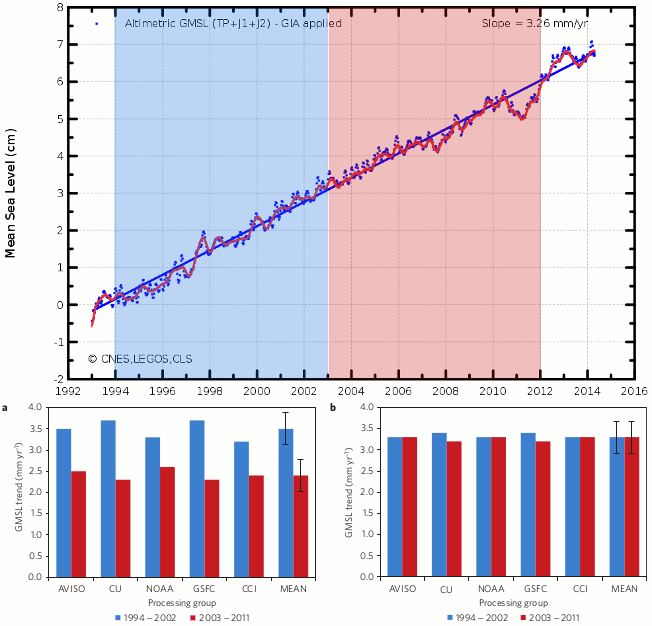

Figure 1 - 1993-2014 global sea-level rise from the AVISO data set (top) with 1994-2002 shaded blue and 2003-2011 shaded red. The lower figure (from Cazenave [2014]) shows a) the measured sea level trends of the five satellite altimetry data sets and their mean for the two periods, and b) the 'actual' sea level trend once corrected for weather-related ocean mass change (and thermal expansion fluctuations). The right-hand bars in b) demonstrate a near-constant rate of 'actual' sea-level rise over the two decades.
After the start of the Industrial Revolution, and due to the geologically-rapid increase in planet-warming gases such as carbon dioxide that accompanied it, global sea level began to rise. This most probably wasn't the case before the onset of human industrial activity, as a wealth of scientific evidence suggests the ocean volume was (effectively) static for 4-5000 years before this.
The reason for the rise in sea level since the 19th century is rather obvious - increased concentrations of greenhouse gases trap heat in the atmosphere and ocean. Seawater expands as it grows warmer, and extra water volume is being added to the oceans through the global-scale disintegration of land-based ice from warming. Not so obvious, however, is the fact that there is a large year-to-year variation in sea level due to fluctuations in the storage of water on land - be it as water or in the form of snow or ice.
These annual fluctuations in continental water storage are largely driven by the El Niño-Southern Oscillation, as this coupled ocean-atmosphere phenomenon determines whether the bulk of precipitation falls over land or ocean. This topic is dealt with in more detail in the SkS Sea Level Fell in 2010 rebuttal, but briefly; during La Niña periods anomalous precipitation typically falls over land, and during El Niño it falls over the ocean.
Even less well-known than these year-to-year natural variations, is that variations in weather patterns can affect global sea-level trends at the scale of not just years, but decades (Ngo-Duc et al [2005]). If, for instance, one decade (or decades) concentrated more rainfall over land (La Niña-dominant, or the negative phase of the Interdecadal Pacific Oscillation [IPO]), this would obscure part of the 'actual' sea-level rise over that period. The opposite would occur during El Niño-dominant (positive IPO) periods as anomalous rainfall over the ocean, combined with drying continental basins, drain water mass back into the sea.
Neither annual, nor decadal-scale, fluctuations in continental water storage affect sea level in the long-term though, as they are driven by variations in weather, but they certainly do complicate determining the precise amount of sea-level rise due to global warming itself, i.e. the rise in global sea level through the addition of glacial meltwater, and the long-term warming of the ocean.
Even though global sea level has very obviously risen in the last decade, several peer-reviewed scientific papers (Ablain et al [2009], Cazenave & Llovel [2010]) have remarked that the rate of sea-level rise over this period has slowed down. Given that the rate of heat uptake by the ocean has increased in recent decades (Von Schuckmann & Le Traon [2011], Levitus [2012], Nuccitelli [2012], and Balmaseda [2013]) and the contribution of glacial meltwater is accelerating (Rignot [2011]), this appears to be a paradox. How can the ocean take up more heat, and how can water be added to the ocean at a greater rate, and yet the apparent rate of sea-level rise decline? Part of the answer to those questions has been provided by a group of French sea-level researchers.
In Cazenave (2014) the study authors combined observations from the GRACE satellites, which are able to detect changes in water mass due to gravitational changes that it induces, along with satellite altimetry measurements of sea surface height. Cazenave (2014) looked at the period from 1994-2011, a time for which detailed satellite altimetry data is available, but, because the GRACE satellites only provide data back to 2003, the authors also made use of a global hydrological (water cycle) model to estimate continental water storage back to 1994. In order to gain a better understanding of the long-term change, the authors also filtered out the year-to-year fluctuations in global sea level due to year-to-year variations in heat uptake - in effect smoothing out the expansion of seawater due to the short-term thermal fluctuations.
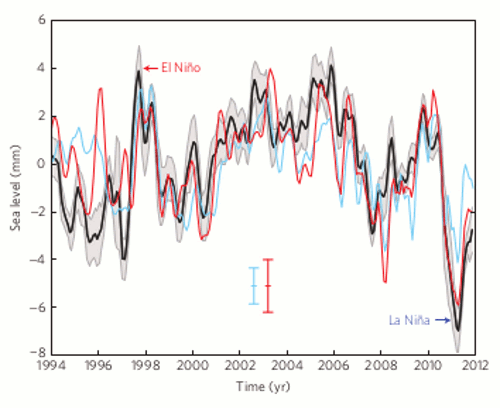
Figure 2 - Detrended global mean sea level between 1994-2011, i.e. the short-term component removed from the long-term global sea level trend. The black line is the average of the five satellite altimetry data sets, with the grey band the associated uncertainty. The light blue line is the hydrological model (land water plus atmospheric water vapour), and the red line the mass and (short-term) thermosteric components. The red & blue vertical bars in the centre are the uncertainty errors for each. Image from Cazenave (2014).
As can be seen in figure 2, the observed sea level trend is strongly biased by variations in continental water storage and short-term fluctuations in thermal expansion, however also see Figure 1 a) & b). Before 2003 these two components of sea-level inflate the rate of sea-level rise, but after 2003 these same two deflate the observed rate of sea-level rise. Removing this 'noise' from the global sea level trend yields a near-constant rate of sea-level rise for the entire period.
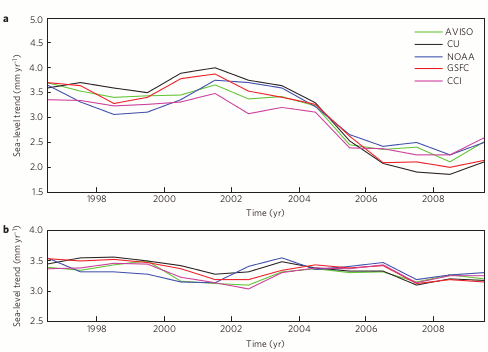
Figure 3 - Global sea level rate for the five satellite altimetry time series calculated over five-year-long moving windows. a) is the observed rate and b) is the rate once corrected for fluctuations in thermal expansion and continental water mass storage. Image from Cazenave (2014).
It should be noted though, that the authors did not include estimates of year-to-year variations in the mass balance of land-based ice, particularly the polar ice sheets of Greenland and Antarctica. The ongoing loss of ice mass is global in nature, but despite the long-term loss there are substantial annual variations in the mass balance because of fluctuations in snowfall in any given year can temporarily offset the loss of ice at the edges of the ice sheets/ice caps. Detailed global data for these fluctuations does not yet exist, but the annual variability implied by estimated changes in mass balance of the Antarctic ice sheet alone - over 300 billion tons of ice (over 0.86mm of sea level equivalent) - suggest that these fluctuations are not trivial.
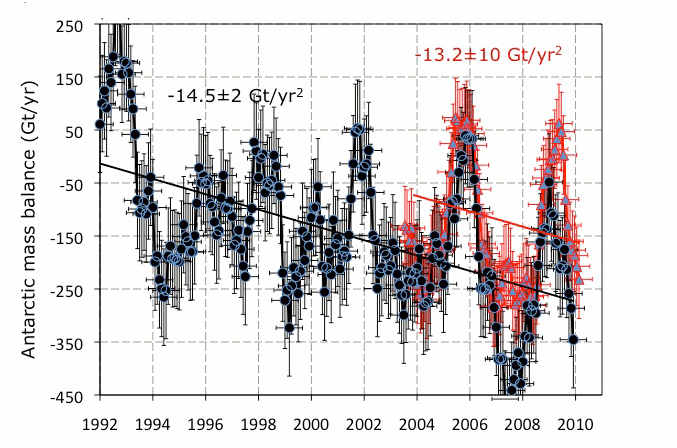
Figure 4 - estimated Antarctic ice sheet mass balance (in billions of tonnes (Gt) per year) for the period 1992-2010. Image adapted from Rignot (2011).
Contrarians are a fringe element within scientific circles due to a distinct lack of evidence to support their claims. Most notably they are lacking in any coherent explanation for continued warming of the climate system. So the slower rate of 'observed' sea-level rise in the last decade has provided yet another opportunity for them to cherry pick (one of the five characteristics of scientific denial) the recent decade in order to insinuate a slowdown in global warming. Contrarians did a similar thing with the sea level fall in 2010 - but that 'pothole' in global sea level was short-lived.
Not only does the continued warming of the ocean and atmosphere refute the notion of a pause, but the analysis by Cazenave (2014) does too, as part of this continued rise is due to thermal expansion (i.e. warming). But the data analyses do raise an interesting question: why is the 'actual' rate of global sea-level rise near-constant when glacial meltwater entering the ocean is accelerating, and there has been a large increase in ocean heat content?
A complete and thorough answer to that question is not yet available, see the above discussion about land-ice fluctuations for instance, but the question overlooks the actual evolution in ocean heat content over recent decades. Although the oceans have certainly warmed much faster in the last 16-17 years, the interval of the so-called pause, than the previous 16-17 years, the rate of uptake of heat by the ocean has not been constant from year-to-year. Once again annual and multi-year fluctuations exert a strong influence on short-term trends and it therefore depends upon which time frame is being examined.
Consider the evolution of ocean heat content in Balmaseda (2013) - arguably the best estimate of ocean warming to date (Figure 5). The interval between 2001-2004/2005 saw an enormous, and as yet unexplained, surge in heat uptake in the tropical oceans. After 2004-2005 the rate of heat uptake by the oceans slowed down. The two time periods, 1994-2002 and 2003-2011, happen to straddle this interval from 2001-2004/2005, greatly affecting the ocean warming rates over these short time frames. A short-term acceleration of ocean warming, followed by a deceleration, is broadly consistent with the analysis by Cazenave (2014), taking into consideration the acceleration of land-ice contribution to ocean volume. The reduction in thermal expansion has probably been counteracted by the increase in water mass.
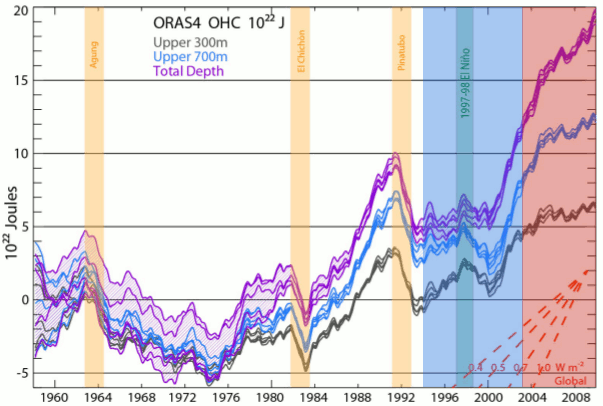
Figure 5 - Ocean warming as depicted by Balmaseda (2013). The blue-shaded column highlighting the 1994-2002 period and red-shaded column the 2003-2009 period. Even without statistical analysis (and the data isn't readily available) it is obvious the ocean heat uptake increases during the earlier interval and tapers off during the latter - general trend evident in two other ocean heat content data sets.
Global sea-level rise may appear to have decelerated during the last decade, however smaller-than-average continental water storage during 1994-2002 combined with greater-than-average continental water storage during 2003-2011 has largely created this false impression. Once corrected for this, and for thermal expansion fluctuations, we find that the 'actual' rise in global sea-level has been near-constant at 3.3 +/- 0.4mm per year.
Warming of the planet is of such a scale that future sea-level rise is inevitable (Meehl (2012). The oceans will take centuries to fully respond to the greenhouse gas-forced warming of the Earth, and the vast polar ice sheets are likely committed to at least partial disintegration. This means that not only will sea level continue to rise, but is almost certain to greatly accelerate at some point. In spite of this, sea-level rise is also bound to exhibit year-to-year fluctuation and even decadal-scale fluctuation, due to the influence of weather. Even the likely future collapse of the West Antarctic ice sheet (Joughlin [2014, Rignot [2014]), will not change that. Don't be surprised, though, if these short-term trends are exploited by contrarians to deny the obvious.
Posted by Rob Painting on Tuesday, 5 August, 2014
 |
The Skeptical Science website by Skeptical Science is licensed under a Creative Commons Attribution 3.0 Unported License. |